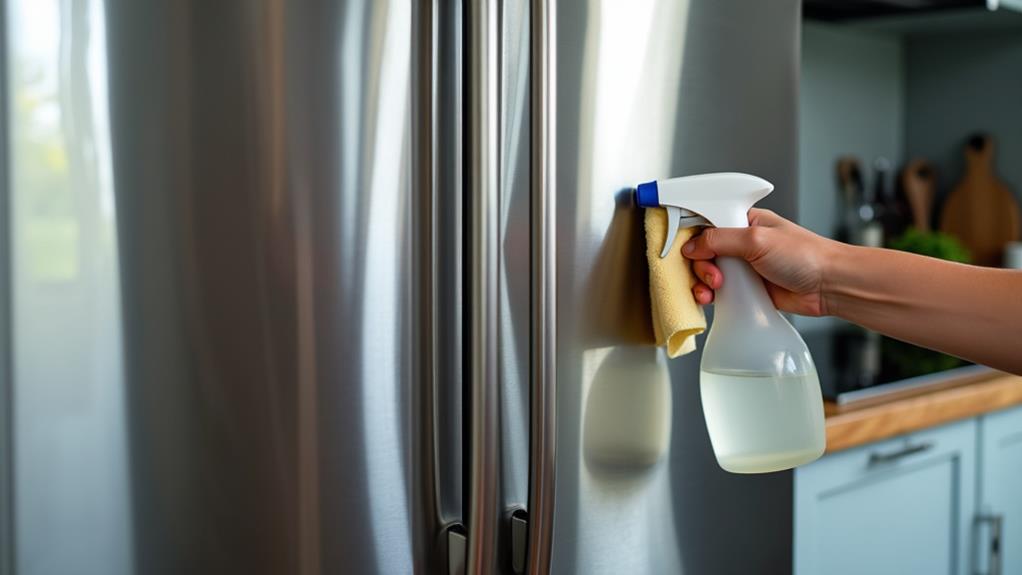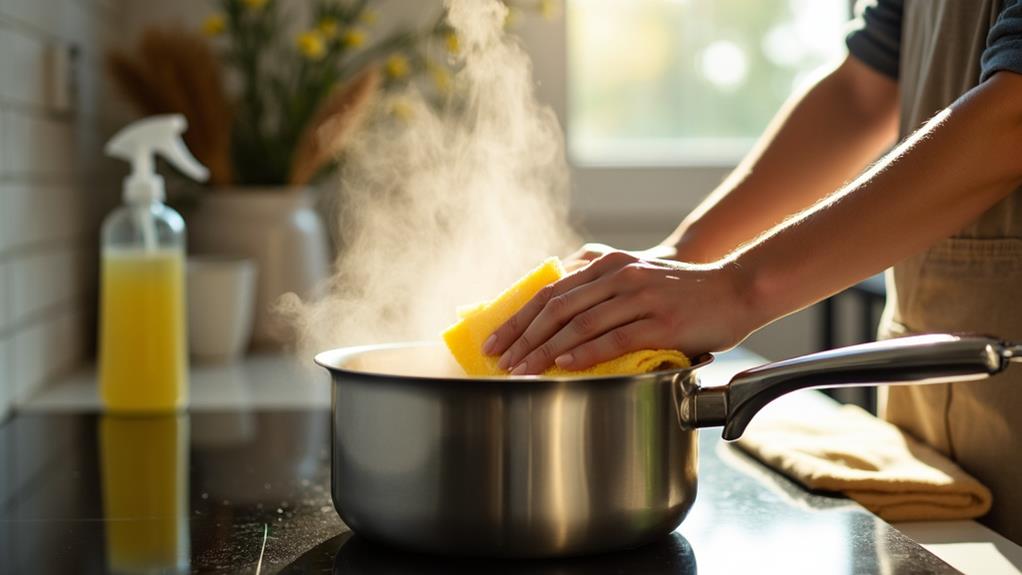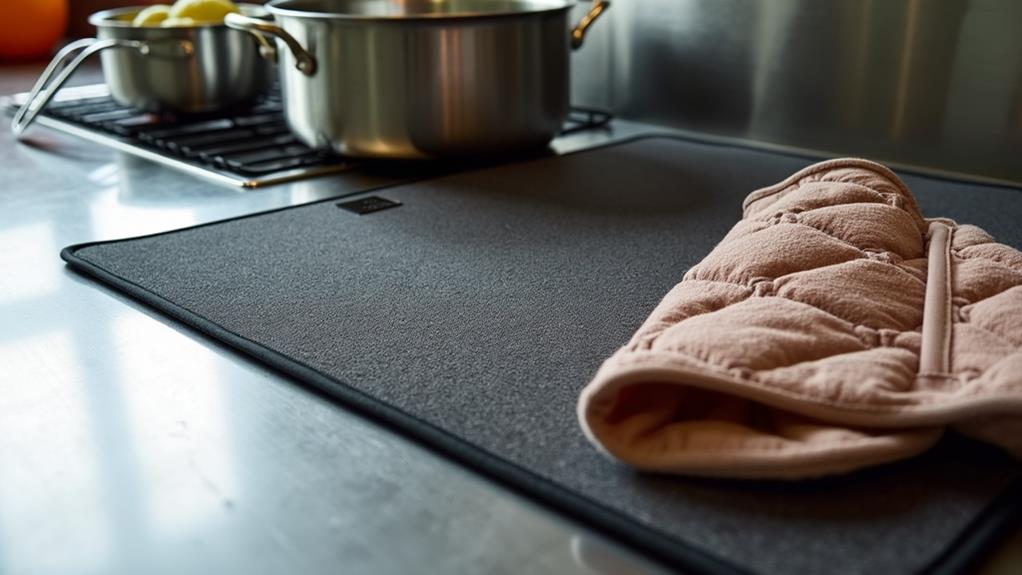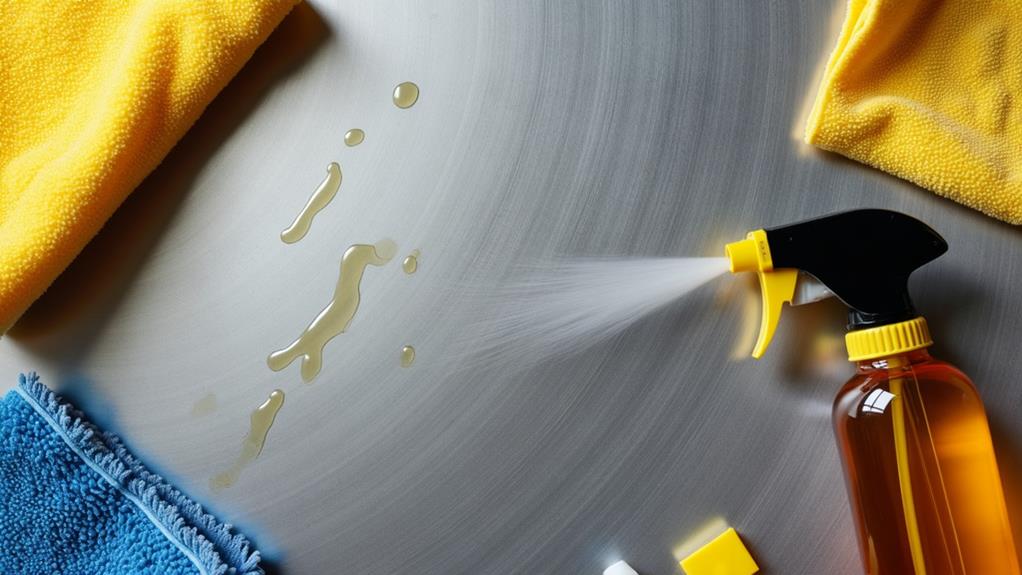How to Get Rid of Hard Water Marks on Stainless Steel
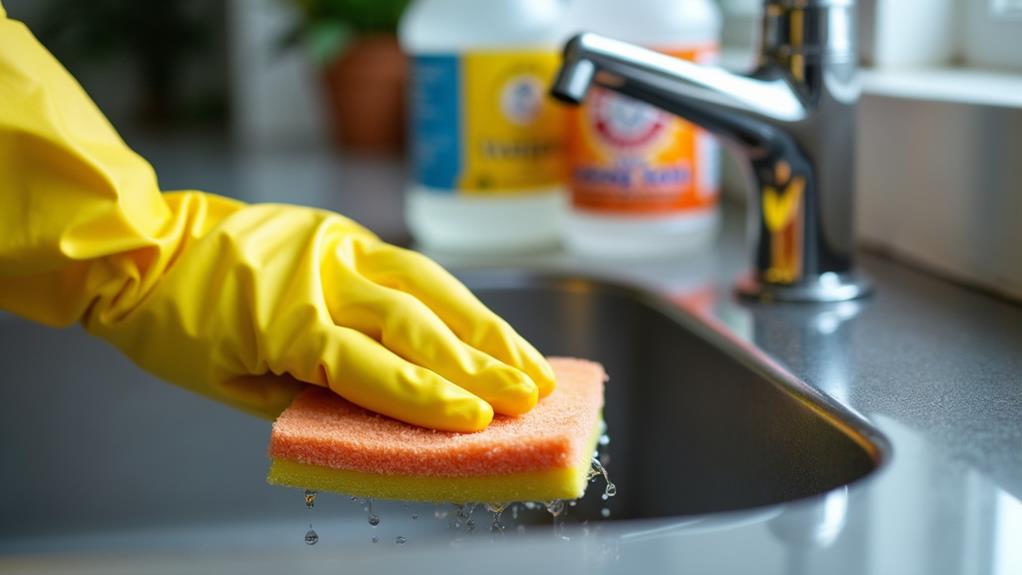
To get rid of hard water marks on stainless steel, start by mixing equal parts vinegar and water. Spray this solution on the marks and let it sit for a few minutes. Scrub gently with a non-abrasive sponge, then rinse with clean water and dry with a microfiber cloth. For tougher stains, use a paste of baking soda and water or apply lemon juice. Magic Erasers can also work wonders. Finish by buffing the area with a few drops of olive oil to prevent future stains. There are more methods and tips that can help maintain that pristine shine.
Understanding Hard Water Marks
Hard water marks, those unsightly white or grayish streaks and spots on your stainless steel surfaces, are a common nuisance. These marks form because hard water contains high levels of minerals like calcium and magnesium. When the water evaporates, it leaves behind mineral deposits, which accumulate and create those pesky stains.
You might notice these mineral deposits on your kitchen sink, dishwasher, or even your stainless steel appliances. They can make your otherwise gleaming surfaces look dull and neglected. The longer you let hard water marks sit, the harder they become to remove, as the minerals bond more firmly with the steel.
Understanding why these marks form is half the battle. When you use water with high mineral content on your stainless steel surfaces, the water evaporates but the minerals don't. This is why you see those persistent streaks and spots. Recognizing this can help you take proactive steps to prevent and tackle them effectively.
Knowing what you're dealing with makes it easier to find the right solutions. You're now better equipped to restore your stainless steel's shine and keep those hard water marks at bay.
Essential Cleaning Supplies
To effectively tackle those stubborn hard water marks on your stainless steel surfaces, you'll need the right cleaning supplies. Start by gathering some crucial cleaning tools: microfiber cloths, non-abrasive sponges, and soft-bristled brushes. Microfiber cloths are perfect for wiping down surfaces without scratching them, while non-abrasive sponges and soft brushes help you scrub away marks without causing damage.
For eco-friendly options, consider using natural ingredients like baking soda and lemon juice. Baking soda acts as a gentle abrasive that can lift hard water stains without harming the steel. Lemon juice not only smells fresh but also contains citric acid, which helps break down mineral deposits. You can use these alongside your microfiber cloths for an effective, planet-friendly cleaning solution.
You might also want a high-quality stainless steel cleaner. Make sure to choose one that's eco-friendly and free from harsh chemicals. Look for products labeled as biodegradable or non-toxic, ensuring they're safe for both your home and the environment.
Armed with these crucial cleaning supplies, you'll be well-prepared to restore your stainless steel surfaces to their shiny, stain-free glory.
Vinegar and Water Solution
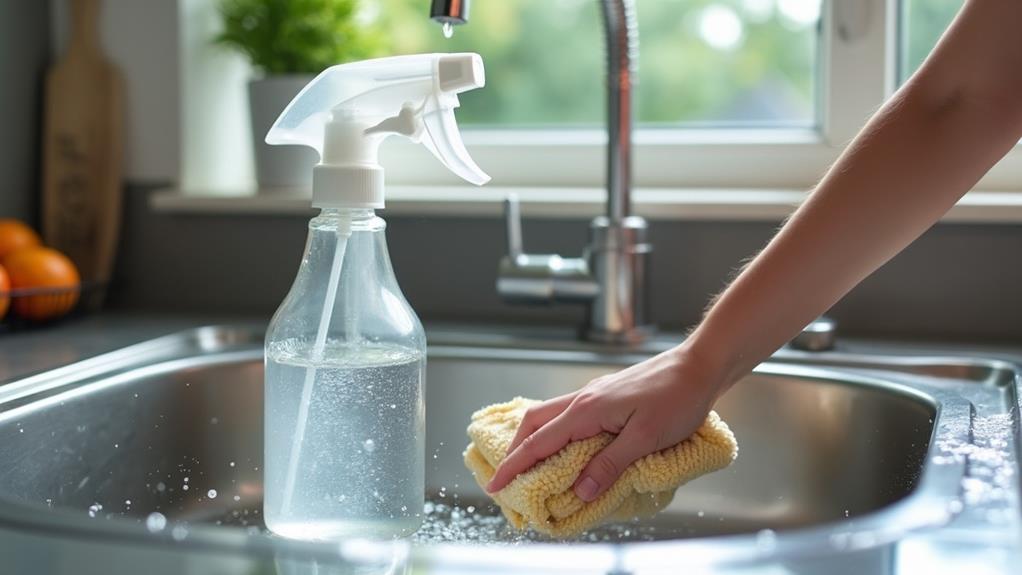
For an effective and easy solution to those pesky hard water marks, mix equal parts vinegar and water. This simple concoction utilizes the vinegar benefits to break down the mineral deposits causing those unsightly stains. Using a 1:1 water ratio guarantees the solution is strong enough to tackle the problem without damaging your stainless steel surfaces.
Start by pouring equal portions of vinegar and water into a spray bottle. Shake well to mix thoroughly. Spray the solution directly onto the hard water marks, making sure the entire affected area is covered. Allow it to sit for a few minutes. This waiting period gives the vinegar time to dissolve the mineral buildup.
After letting it sit, use a soft cloth or sponge to gently scrub the area. You'll notice the hard water marks beginning to lift away. Rinse the surface with clean water to wash away any remaining solution, and then dry it with a microfiber cloth to prevent new water spots from forming.
The vinegar and water solution is not only effective but also eco-friendly and inexpensive. It's a quick fix that saves you time and keeps your stainless steel looking pristine.
Baking Soda Paste
While the vinegar and water solution works wonders, sometimes those stubborn hard water marks need a bit more muscle. That's where a baking soda paste comes in handy. One of the greatest baking soda benefits is its mild abrasive property, making it perfect for tackling tough stains without scratching your stainless steel.
To create your paste, follow these simple steps:
- Mix Baking Soda and Water: Combine three parts baking soda with one part water. Stir until you achieve a thick, spreadable consistency.
- Apply the Paste: Use a soft cloth or sponge to spread the paste over the hard water marks. Make sure to cover all affected areas thoroughly.
- Scrub Gently: Gently scrub in a circular motion. The baking soda applications will help break down the mineral deposits without damaging the surface.
After scrubbing, rinse the area with clean water and dry it with a soft towel to prevent new marks from forming. You'll notice that those pesky hard water spots are remarkably reduced or even completely gone. This method not only leaves your stainless steel sparkling but also utilizes the natural power of baking soda, making it a safe and eco-friendly cleaning solution.
Lemon Juice Application
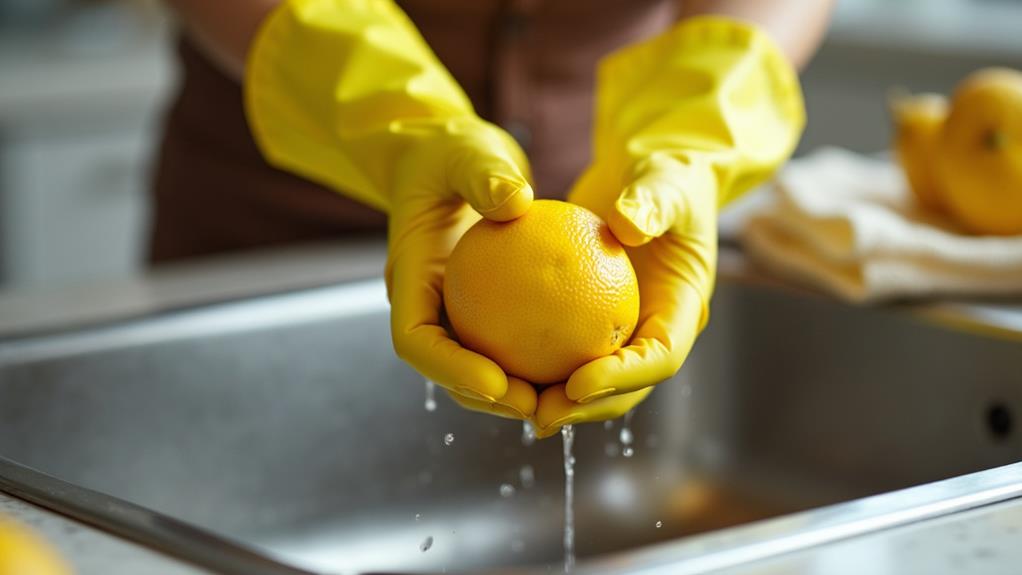
Lemon juice is another excellent natural cleaner that can help you get rid of hard water marks on stainless steel. The citric acid in lemons works effectively to break down mineral deposits and restore the shine to your surfaces. Plus, lemon benefits include a pleasant, fresh scent that leaves your kitchen smelling great.
To start, cut a fresh lemon in half and squeeze the juice directly onto the hard water marks. Using a soft cloth or sponge, gently rub the juice into the stainless steel surface. The natural cleaner properties of the lemon juice will begin to dissolve the stubborn mineral deposits. Allow the lemon juice to sit for about 5-10 minutes to enhance its effectiveness.
After the waiting period, use a damp cloth to wipe away the lemon juice and loosened mineral deposits. For extra shine, you can follow up with a dry microfiber cloth to buff the surface. This method not only removes hard water marks but also leaves your stainless steel looking polished and streak-free.
Using lemon juice is a simple, eco-friendly way to keep your stainless steel appliances in top condition without resorting to harsh chemicals.
Commercial Cleaners
When natural cleaners aren't enough to tackle tough hard water marks, commercial cleaners can provide a powerful alternative. Regardless of if you're dealing with stubborn stains or just want a quick, effective solution, several high-quality products are available. Here are a few options to evaluate:
- Eco-Friendly Options: If you're concerned about the environment, look for brands that offer eco-friendly cleaners. These products often use biodegradable ingredients, making them safe for both your home and the planet. Brands like Seventh Generation and Method are well-regarded for their green cleaning solutions.
- Best Brands for Stubborn Stains: When you need something more robust, think about leading brands like Bar Keepers Friend or Weiman. These cleaners are specifically formulated to tackle hard water marks and leave your stainless steel surfaces sparkling clean. They're highly effective and trusted by many users.
- Specialty Products: Some commercial cleaners are formulated to handle specific types of stains or surfaces. For instance, products like CLR (Calcium, Lime, and Rust Remover) are designed to target hard water deposits. This can be particularly useful if your stainless steel surfaces are regularly exposed to hard water.
Using commercial cleaners can make a significant difference, especially when eco-friendly options and the best brands are evaluated.
Using a Magic Eraser
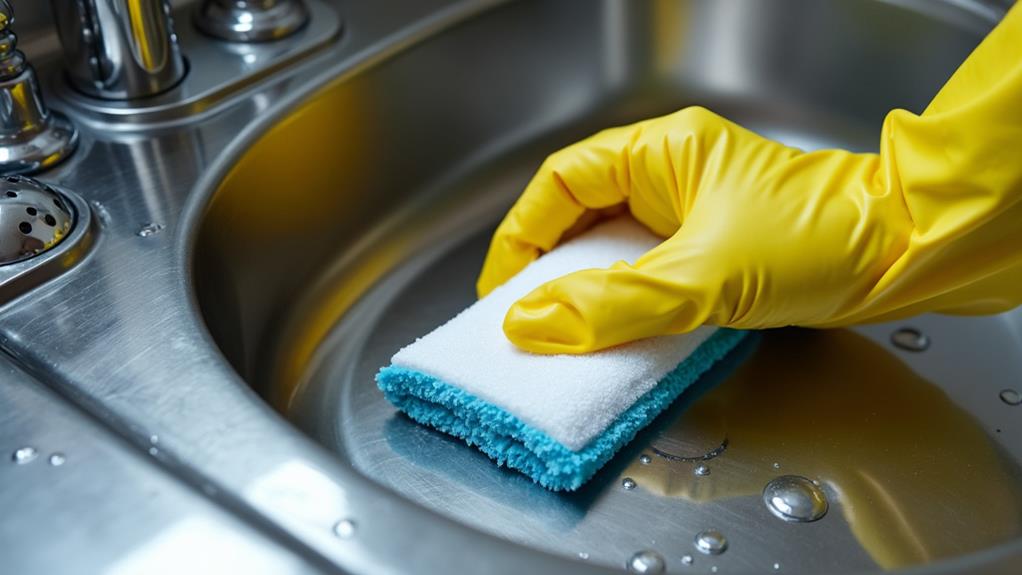
For a quick and efficient way to get rid of hard water marks on stainless steel, consider using a Magic Eraser. This cleaning tool is known for its effectiveness in tackling stubborn stains and marks that other methods might miss. To start, dampen the Magic Eraser with water—there's no need for harsh chemicals. Gently rub the eraser on the affected area in a circular motion. You'll notice the hard water marks begin to lift away almost immediately.
The magic eraser effectiveness stems from its micro-abrasive properties, which help break down and remove mineral deposits without overly scrubbing. However, you should be cautious while using it to guarantee surface protection. Although the eraser is generally safe for stainless steel, applying too much pressure can potentially dull the finish.
After you've removed the water marks, wipe the area clean with a soft, damp cloth to remove any residue. It's a good practice to dry the surface thoroughly to prevent future water spots. By using a Magic Eraser, you can restore the sleek look of your stainless steel appliances and fixtures with minimal effort and outstanding results.
Olive Oil Finish
Although it might seem unconventional, using olive oil can be an effective way to maintain the shine of your stainless steel surfaces. Olive oil benefits your stainless steel by adding a layer of protection that can prevent future water marks and smudges. Plus, it's a natural, eco-friendly option that you likely already have in your kitchen.
Here's how you can use olive oil to improve your stainless steel shine:
- Clean the Surface: Initially, make sure to clean your stainless steel surface thoroughly. Use a damp cloth with mild soap to remove any dirt or residue. Dry it completely with a soft towel.
- Apply Olive Oil: Put a few drops of olive oil on a microfiber cloth. Gently rub the oil onto the stainless steel surface, following the grain. This helps in evenly distributing the oil and bringing out the natural luster.
- Buff the Surface: Ultimately, use a clean, dry microfiber cloth to buff the surface. This will remove any excess oil, leaving your stainless steel looking shiny and streak-free.
Preventative Measures
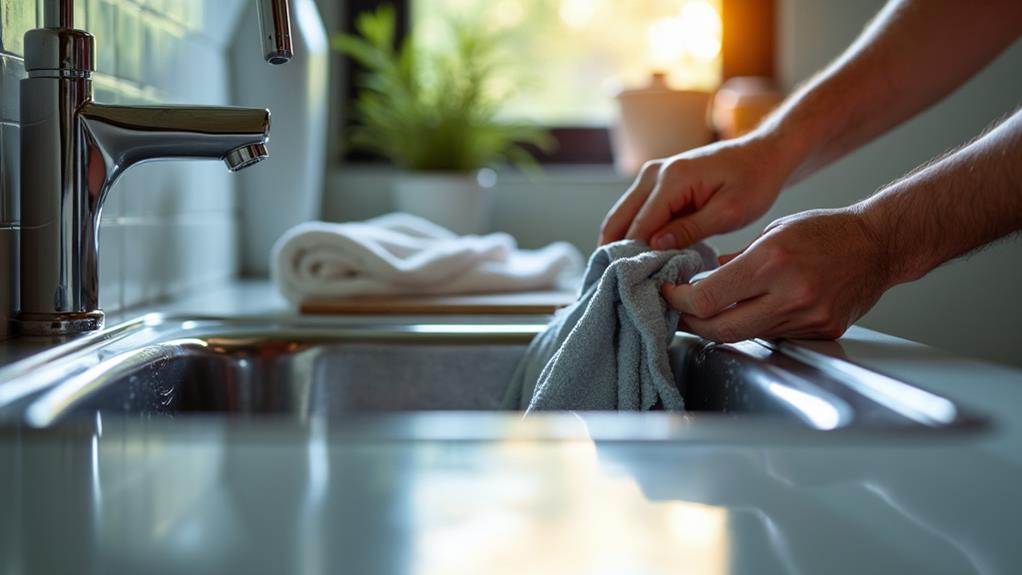
After enhancing the shine of your stainless steel with olive oil, it's just as crucial to adopt preventative measures to keep it looking pristine. One effective strategy is to install water softeners in your home. Hard water, rich in minerals like calcium and magnesium, is a primary culprit behind those stubborn water marks. A water softener will reduce these minerals, preventing them from bonding to your stainless steel surfaces in the beginning.
Additionally, applying protective coatings can be a game-changer. These coatings create a barrier between the stainless steel and water, making it harder for minerals to adhere. You can find these protective products at most home improvement stores. Confirm you follow the manufacturer's instructions for the best results.
Regular Maintenance Tips
Maintaining the gleam of your stainless steel requires consistent care. Routine cleaning is key to avoiding the buildup of hard water marks and ensuring your surfaces always look their best. Here are some practical tips to keep your stainless steel in top shape:
- Daily Wipe Down: Make it a habit to wipe down your stainless steel surfaces daily. Use a soft cloth and a mixture of warm water and mild dish soap. This simple step can prevent the accumulation of minerals and grime.
- Weekly Deep Clean: Once a week, perform a more thorough cleaning. Use a non-abrasive cleaner specifically designed for stainless steel care. Apply the cleaner with a microfiber cloth, following the grain of the steel to avoid scratches.
- Polishing Routine: To maintain that polished look, periodically use a stainless steel polish. Apply it with a clean, dry cloth, and buff in circular motions. This not only improves the shine but also adds a protective layer against future water marks.

